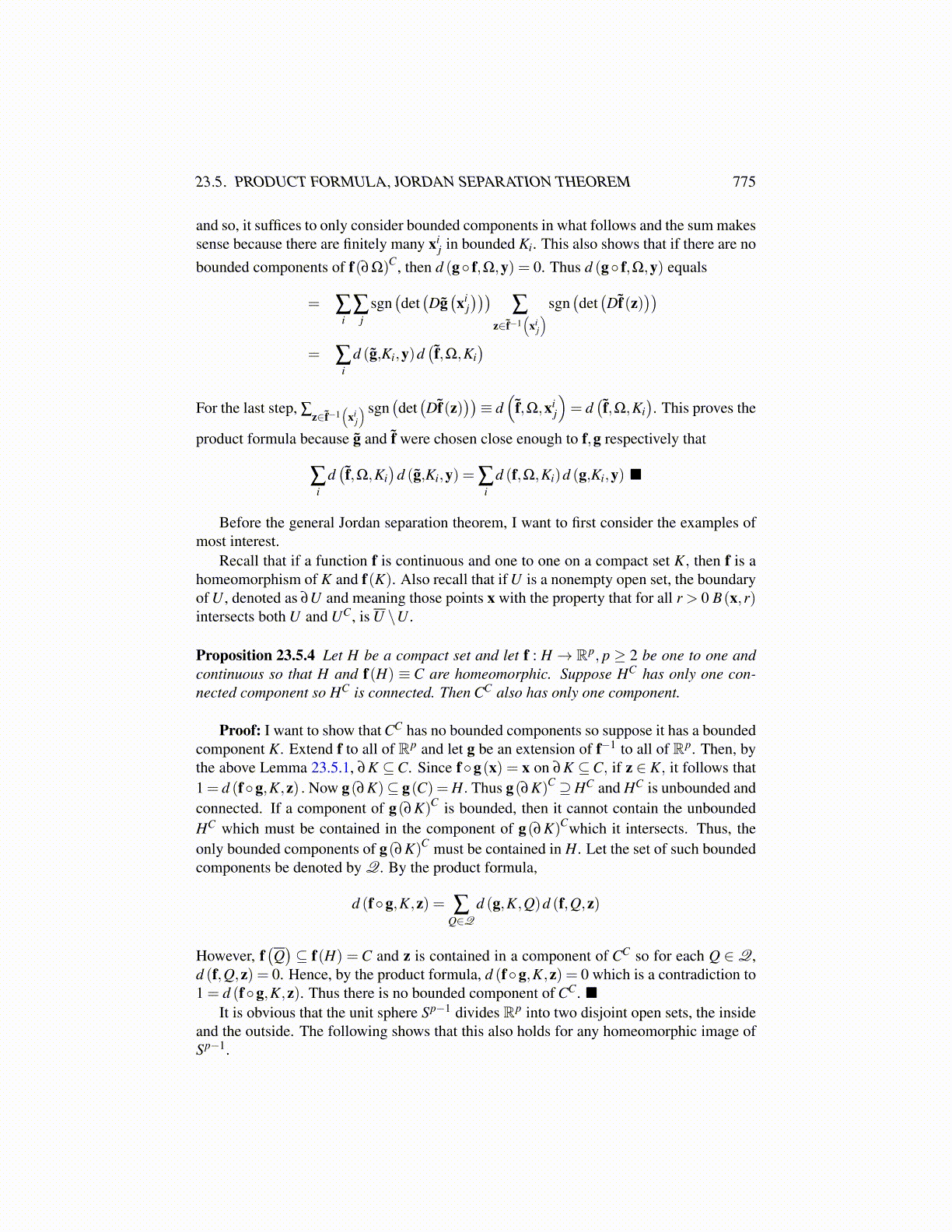
23.5. PRODUCT FORMULA, JORDAN SEPARATION THEOREM 775
and so, it suffices to only consider bounded components in what follows and the sum makessense because there are finitely many xi
j in bounded Ki. This also shows that if there are nobounded components of f(∂Ω)C, then d (g◦ f,Ω,y) = 0. Thus d (g◦ f,Ω,y) equals
= ∑i
∑j
sgn(det(Dg̃(xi
j)))
∑z∈f̃−1
(xi
j
)sgn(det(Df̃(z)
))= ∑
id (g̃,Ki,y)d
(f̃,Ω,Ki
)For the last step, ∑z∈f̃−1
(xi
j
) sgn(det(Df̃(z)
))≡ d
(f̃,Ω,xi
j
)= d
(f̃,Ω,Ki
). This proves the
product formula because g̃ and f̃ were chosen close enough to f,g respectively that
∑i
d(f̃,Ω,Ki
)d (g̃,Ki,y) = ∑
id (f,Ω,Ki)d (g,Ki,y)
Before the general Jordan separation theorem, I want to first consider the examples ofmost interest.
Recall that if a function f is continuous and one to one on a compact set K, then f is ahomeomorphism of K and f(K). Also recall that if U is a nonempty open set, the boundaryof U , denoted as ∂U and meaning those points x with the property that for all r > 0 B(x,r)intersects both U and UC, is U \U .
Proposition 23.5.4 Let H be a compact set and let f : H → Rp, p ≥ 2 be one to one andcontinuous so that H and f(H) ≡ C are homeomorphic. Suppose HC has only one con-nected component so HC is connected. Then CC also has only one component.
Proof: I want to show that CC has no bounded components so suppose it has a boundedcomponent K. Extend f to all of Rp and let g be an extension of f−1 to all of Rp. Then, bythe above Lemma 23.5.1, ∂K ⊆C. Since f◦g(x) = x on ∂K ⊆C, if z ∈ K, it follows that1 = d (f◦g,K,z) . Now g(∂K)⊆ g(C) = H. Thus g(∂K)C ⊇HC and HC is unbounded andconnected. If a component of g(∂K)C is bounded, then it cannot contain the unboundedHC which must be contained in the component of g(∂K)Cwhich it intersects. Thus, theonly bounded components of g(∂K)C must be contained in H. Let the set of such boundedcomponents be denoted by Q. By the product formula,
d (f◦g,K,z) = ∑Q∈Q
d (g,K,Q)d (f,Q,z)
However, f(Q)⊆ f(H) = C and z is contained in a component of CC so for each Q ∈Q,
d (f,Q,z) = 0. Hence, by the product formula, d (f◦g,K,z) = 0 which is a contradiction to1 = d (f◦g,K,z). Thus there is no bounded component of CC.
It is obvious that the unit sphere Sp−1 divides Rp into two disjoint open sets, the insideand the outside. The following shows that this also holds for any homeomorphic image ofSp−1.